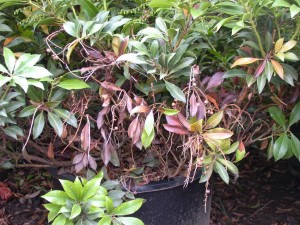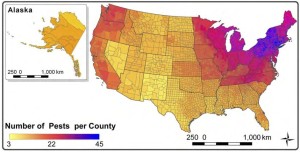Sixteen scientists and policy analysts (including me) have published a new study reviewing recent work on numbers, pathways and impacts of non-native, tree-killing insects and pathogens. I encourage you to read the article. It provides a concise and compelling overview of the threat to our wildland, rural, and urban forests from non-native insects and diseases and proposes some thought-provoking solutions.
rhododendron infected by sudden oak death; photo by Jennifer Parke, Oregon State University
Meanwhile, here are our conclusions:
Current policies for preventing introductions have reduced the numbers of pests introduced via the various pathways (e.g., wood packaging and horticultural plants – but not sufficiently to counter pests’ rising opportunities for introduction resulting from burgeoning global trade. [Emphasis mine.]
At the current efficacy of implementing the international regulations governing wood packaging [ISPM #15] ( Haack et al., 2014), and given growing trade, Leung et al. 2014 project that by 2050 – just 35 years from now – up to three times as many wood-boring insects may be introduced to the U.S. as are currently here.
(I discussed this high risk in blogs posted at this site on July 15 and August 22, 2015.)
The new paper presents several options for improving prevention. These include: measures to ensure exporters ship “clean” plants and wood packaging; post-entry quarantines to raise the likelihood that pests will be detected; placing all genera of North American woody plants on USDA’s NAPPRA list of genera not currently approved for import and awaiting risk assessment; and improved surveillance and eradication programs. We also note the importance of improving data collection and allowing researchers outside USDA access to those data to support independent evaluation of policy’s effectiveness.
As Aukema et al. demonstrated six years ago, non-native forest insects have accumulated in U.S. forests at a steady rate of about 2.5 per year over the last 150 yrs. While the rate of introduction has not changed, the types of insects introduced have. In the 20th Century, plant-associated insects dominated the introductions. In recent years wood-boring insects associated with wood packaging materials have dominated. Some of these wood-borers also are highly damaging! (See emerald ash borer, redbay ambrosia beetle/laurel wilt, and polyphagous shot hole borer/Fusarium here). Lack of information precludes a similar analysis for pathogens; although we all know that the 20 or so high-profile pathogens cause great devastation – see descriptions here.
The whole country is at risk; although the highest numbers of tree-killing insects and pathogens are established in the Northeast and Midwest, Pacific Coast states are catching up (and certainly already have their share of devastating insects and pathogens). See the map below. You can check the pests in your state by visiting the interactive map here .
map developed by USFS; published in Aukema et. al 2010.
Our new article notes that these non-native pests are the only disturbance agent that has effectively eliminated entire tree species or genera from U.S. forests in the span of decades. Follow-on effects include alterations of ecosystem functions and huge costs to various stakeholders, especially residents and governments of (sub)urban areas.
These impacts can persist for centuries as a result of altered species composition, which affects multiple trophic levels.
We followed Aukema et al. 2011’s results in estimating the direct annual economic impact of non-native forest insects to be at least: $2 billion in municipal government expenditures, $1.5 billion in lost residential property values, and $1 billion in homeowner expenditures for tree removal and replacement or treatment. These costs and losses contrast with the paltry $216 million estimated in federal government expenditures.
Aukema et al. 2011 noted that these expenses cannot be summed across cost categories because of the potential for double-counting. We note that these figures are probably underestimates for several reasons. They did not include the introduced diseases such as sudden oak death. Nor do they include pests detected recently, such as the polyphagous shot hole borer. Finally, our paper excluded consideration of insects or pathogens native to some part of North America, such as the goldspotted oak borer. (For more information about these organisms, consult the write-ups here.)
As our article notes, the billions of dollars in annual economic damages (and un-quantified ecological impacts) are economic externalities. That is, the importers who benefit from the economic activity do not pay directly for preventing or responding to the associated pest introductions.
The article discusses several policy options that we believe would greatly reduce unacceptable risks. These options include several bold actions:
- Require importers to switch from packaging made from wooden boards to packaging made from materials other than solid wood (fiberboards ok). This change is both highly protective and potentially cost-effective. Such a switch would have to be justified under the terms of international trade agreements – but given the high levels of damage caused by wood-boring pests, I don’t think that hurdle is insurmountable.
- Greatly strengthen measures aimed at preventing pest introduction on imports of plants. One step would be restricting imports of all genera of “woody” plants native to North America by designating them as “not authorized for importation pending pest risk assessment” (NAPPRA). Another protective step would be to promptly finalize the Q-37 revision proposed by USDA in April 2013 and immediately initiate negotiations with principal foreign suppliers of temperate climate woody vegetation to implement the pest-minimization procedures contained in that revised regulation, as well as in ISPM#36.
Other options discussed are straight-forward and simpler:
- Tighten enforcement of existing regulations by ending the practice of allowing an importer to be detected five times in a year with wood packaging that does not comply with regulatory requirements before imposing a penalty. When a new year starts, that importer gets a “clean slate”! Is this how agencies enforce regulations that they are serious about?
- Expand efforts to assist trade partners in adopting clean trade measures.
- Expand and integrate surveillance programs for new pest outbreaks, and providing timely and adequate funding for emergency eradication efforts.
SOURCES
Aukema, J.E., B. Leung, K. Kovacs, C. Chivers, K. O. Britton, J. Englin, S.J. Frankel, R. G. Haight, T. P. Holmes, A. Liebhold, D.G. McCullough, B. Von Holle.. 2011. Economic Impacts of Non-Native Forest Insects in the Continental United States PLoS One September 2011 (Volume 6 Issue 9)
Aukema, J.E., D.G. McCullough, B. Von Holle, A.M. Liebhold, K. Britton, & S.J. Frankel. 2010. Historical Accumulation of Nonindigenous Forest Pests in the Continental United States. Bioscience. December 2010 / Vol. 60 No. 11
Haack, R. A., K. O. Britton, E. G. Brockerhoff, J. F. Cavey, L. J. Garrett, M. Kimberley, F. Lowenstein, A. Nuding, L. J. Olson, J. Turner, and K. N. Vasilaky. 2014. Effectiveness of the international phytosanitary standard ISPM no. 15 on reducing wood borer infestation rates in wood packaging material entering the United States. Plos One 9:e96611.
Leung, B., M. R. Springborn, J. A. Turner, and E. G. Brockerhoff. 2014. Pathway-level risk analysis: the net present value of an invasive species policy in the US. Frontiers in Ecology and the Environment 12:273-279.
Posted by Faith Campbell

